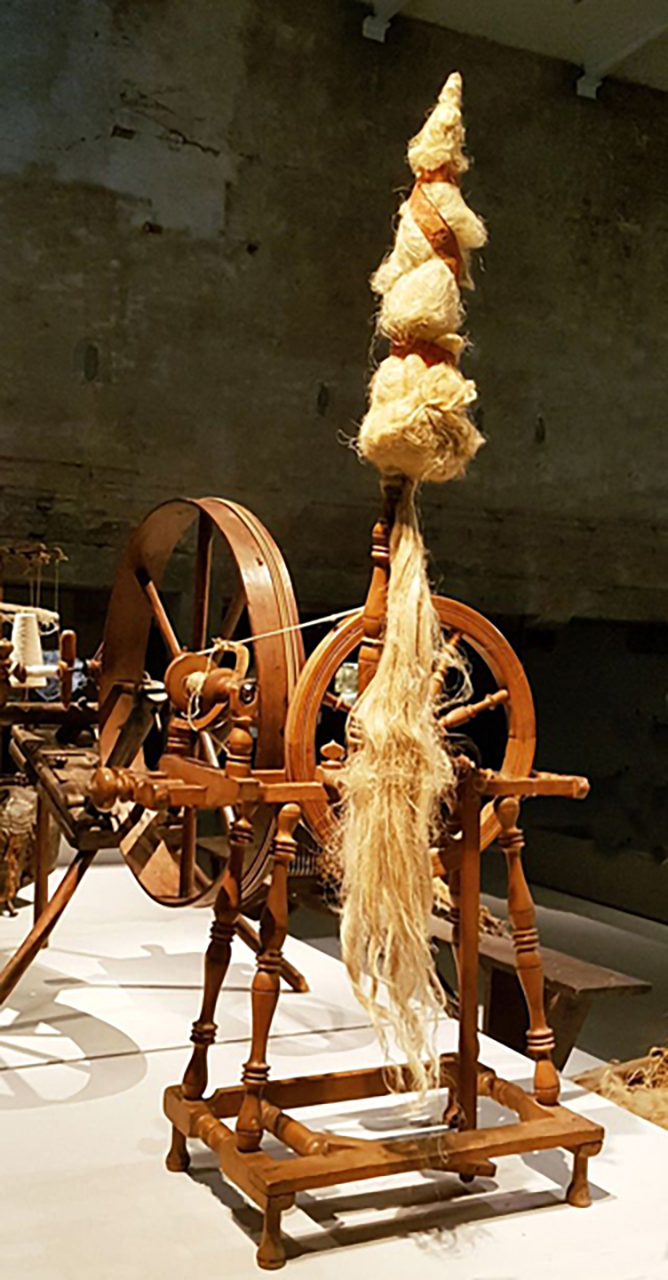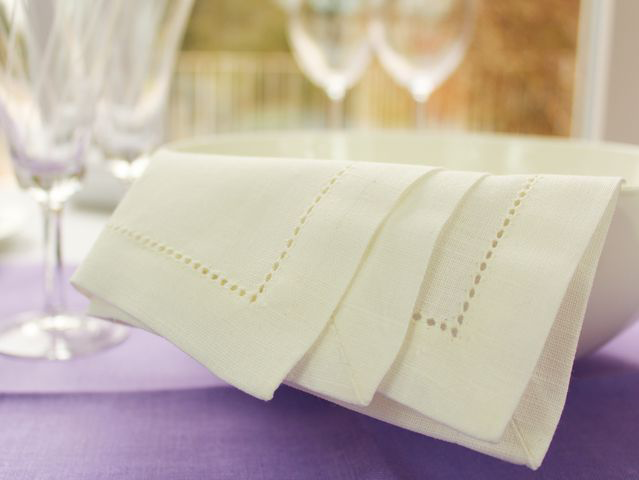From Flax to Linen —
from Linen to Linen Tablecloths and Linen Napkins
from Linen to Linen Tablecloths and Linen Napkins
The cultivated plant flax has been widespread in the Mediterranean region since the 2nd millennium BC.
Through Spain, flax – from which linen tablecloths were already produced at an early stage –
came to Western Europe.
The flax plant is one of the oldest plants cultivated by humans and still thrives today
in Western Europe thanks to the moderately warm summer temperatures and mild climate.
 The flax flower blooms in blue or white, and its seeds are called linseed.
They form the basis of our linen tablecloths and linen napkins.
The word linen (Greek “linon”, Latin “linum” = flax) refers both to the fiber of the flax plant and to the fabric woven from it,
also known as canvas or linnen.
The flax flower blooms in blue or white, and its seeds are called linseed.
They form the basis of our linen tablecloths and linen napkins.
The word linen (Greek “linon”, Latin “linum” = flax) refers both to the fiber of the flax plant and to the fabric woven from it,
also known as canvas or linnen.
From the late 19th century onwards, linen was largely replaced by cotton in many areas.
Today, however, linen fabrics are once again gaining importance and popularity as sustainable natural fibers.
Flax fibers are known for their high tensile strength, which makes them especially suitable for textile production,
particularly for durable linen tablecloths.
The fabric made from the flax plant is called linen or canvas.
In earlier times, linen was not only used for linen clothing and household textiles but also for making ship sails.
For linen production, the bast fibers located in the bark tissue of the flax stems are used.
These fibers, measuring about 30–90 cm in length, were traditionally extracted through a very intensive and laborious process.
Sowing Flax for Linen Production
The process begins each spring, when linseed is sown in late April or early May.
Flax is an annual crop and must be replanted each year. After a few days, the delicate green shoots appear, and careful weeding ensures a healthy harvest.
As an old proverb says: “Poor flax makes no good yarn.”
After about 100 days, usually by the end of July, the plants turn golden-yellow and are ready for harvesting.
Unlike other crops, flax is not cut but carefully pulled out with its roots to preserve the fibers.
The harvested bundles are then dried in the field before further processing begins.
Retting – Preparing the Flax Fibers
To transform flax into strong linen fibers, the stalks undergo a process called retting. The seed capsules are first removed and pressed into linseed oil, a valuable by-product. The stems are then soaked in water, where moisture triggers a natural fermentation that loosens the bast fibers from the woody core. This stage lasts around 10–14 days and must be carefully monitored to avoid damaging the fibers. After retting, the stems are spread out to dry and turned repeatedly until they are brittle enough for the next step. On large farms, special flax drying ovens were even used to speed up the process.
Breaking the Stems – Releasing the Linen Fibers
Once dried, the flax stems are “broken.” Traditionally, this meant striking them with a grooved wooden mallet on a block to crush the woody parts and release the long, silky fibers. Smaller batches were processed by hand, while larger harvests were taken to horse-powered mills, where the work was done on a much larger scale. These precious fibers would then be combed, spun, and woven into fabric – the foundation of high-quality linen tablecloths and linen napkins.
Linen Today – Sustainable Elegance
For centuries, linen fabric was used not only for table linens and clothing, but also for ship sails and many everyday items. In the 19th century, cotton replaced linen in many areas. Yet today, linen is enjoying a comeback as one of the most eco-friendly and sustainable natural fibers available. Its high tensile strength, breathability, and elegant texture make it the ideal choice for timeless home textiles such as linen tablecloths, linen napkins, and runners. Whether in traditional households or modern interiors, linen continues to embody both natural simplicity and refined elegance.
Spinning the canvas for linen tablecloths
During spinning, individual fibers are twisted together
to create the finest, most even thread possible.
This is particularly important
for linen tablecloths. A spindle is used for spinning: a wooden rod approximately
30 cm long. The spindle twists the attached thread by rotating around its own axis.
 This ancient spinning process is documented in Central Europe as
early as the Neolithic period (5000-2000 BC).
This ancient spinning process is documented in Central Europe as
early as the Neolithic period (5000-2000 BC).
It wasn't until the
Middle Ages that the spinning process was mechanized with the use
of a hand spinning wheel, with spinning and winding the thread
initially taking place sequentially. It wasn't until the development
of the flywheel around 1480 that spinning and winding the yarn could
be completed in a single operation. The spun thread was wound onto a reel.
The reel resembles a spoked wheel, with small crosspieces instead of a hoop
that hold the yarn.
Since ancient times, 60 threads have formed a yarn,
with 20 yarns constituting a single piece.
Weaving linen tablecloths<
When weaving linen for linen tablecloths and linen
napkins, the threads are crossed at right angles. First, the warp threads
are stretched parallel to each other at equal intervals. The weft threads
are passed from the side, alternately over and under the warp threads. This
is also called the "weft thread," "weft thread," or simply "weft."
Even in
ancient times, the loom made crossing the threads much easier: With the help
of lifting beams and shafts, the warp threads were alternately raised and lowered.
This allowed the shuttle with the weft thread to be moved quickly. The weaver had
to tap each thread firmly against the already woven linen after each throw.
Linen can absorb well over 30 percent of humidity and quickly exchange this
moisture with the surrounding air. This makes it both cooling and warming, making
it an ideal fabric, especially for summer clothing. The linen fiber is extremely
tear-resistant and inelastic, which is why it is also very prone to creasing. This
high tear resistance makes linen durable, but also susceptible to friction. It should
therefore only be compressed in the wash and not rubbed.
Linen and linen tablecloths are strong and do not need to be starched.
Linen is resistant to many washing solutions and detergents and can be ironed at
very high temperatures while still damp. However, linen and linen tablecloths
should not be tumble dried, as the dry heat will permanently damage the fabric.
Bleaching the canvas for linen tablecloths and linen napkins
The linen was then boiled in a wood ash solution or soap solution,
which was then washed out again in many laborious rinses. This removed the lignin, the fiber glue, from the linen, but it was only through bleaching in the
summer months from May to July that the linen acquired its true light color.
The farmers usually bleached their linen themselves by spreading the hemmed linen in strips
on meadows and regularly sprinkling it with ditch water.
The linen was repeatedly doused with water and then bleached for hours in the sun.
 The chemical processes used in lawn bleaching are still artificially imitated
in modern detergents and bleaching agents. During the final drying process
in the hot summer sunlight, the last wrinkles were carefully smoothed out of the
linen, the linen was smoothed out, and finally rolled up before it could be further processed,
e.g., into linen tablecloths.
The chemical processes used in lawn bleaching are still artificially imitated
in modern detergents and bleaching agents. During the final drying process
in the hot summer sunlight, the last wrinkles were carefully smoothed out of the
linen, the linen was smoothed out, and finally rolled up before it could be further processed,
e.g., into linen tablecloths.
Woven linen itself varies greatly, from very finely woven to coarse sackcloth,
which was used for grain sacks in ancient times because of its high tensile strength.
A distinction is also made between bleached and unbleached linen, smooth or patterned
linen, and dyed and undyed linen.
The majority of woven linen was sold by many farmers; linen tablecloths were made from
particularly high-quality, finely woven, and lightly bleached cloth.
The sale of linen
was carried out by traveling merchants who bought the fabric in bales
uncut and marketed it nationwide.
The farmers also kept some of the linen for themselves; because it was so valuable,
it was often given to the girls of the household as a dowry at marriage.
Linen
and linen tablecloths
and other
table linens
were stored in old oak chests, which had to be airy and dry to prevent the linen from becoming
brittle. An old saying describes this: "Mit Fleiß
gesponnen, gebleicht am Bronnen, gewebt zu Linnen, liegt still hier innen."
(found in: M. Fasse, Von Flachs und Leinen in alter Zeit. Berichte und Bilder,
Dokumente und Überlieferungen, Rheda-Wiedenbrück 1989, S. 91.) The linen
treasure that was stored was considered very valuable: linen tablecloths with hemstitches,
linen tablecloths with lace inserts, valuable embroidery on linen table linen and bed linen,
linen napkins with letter corners, decorative pillows, and parade cushions were all stored
here and were symbols of a family's prosperity and wealth. The individual piles of linen in
the old chests and cupboards were traditionally held together with ribbons.
Literature used for this article:
- Fasse, Marianne, Rund um Flachs und Leinen, Sprichwörter und Redensarten, Volksglaube und Brauchtum, Gedichte, Lieder und Märchen aus der Spinnstube, Münster 2003.
- Fasse, Marianne, Von Flachs und Leinen in alter Zeit, Berichte und Bilder, Dokumente und Überlieferungen, Rheda-Wiedenbrück 1989.
- Schoneweg, Eduard, Das Leinengewerbe in der Grafschaft Ravensburg. Ein Beitrag zur niederdeutschen Volks- und Altertumskunde. Nach der Ausgabe von 1923 ergänzt um einen Beitrag von Heinz Potthoff, Das Ravensbergische Leinengewerbe im 17. Und 18. Jahrhundert und ein Verzeichnis der mundartlichen Fachausdrücke, herausgegeben von Ernst Helmut Segschneider, Osnabrück 1985.
- Diers, Hedwig, Die schönsten Leinen-Stickereien, Münster 1993.
Further literature on linen production:
- Eduard Schoneweg, Das Leinengewerbe, ein Beitrag zur niederdeutschen Altertumskunde, Osnabrück 1985.
- Ottfried Dascher, Das Textilgewerbe in Hessen-Kassel vom 16. bis 19. Jahrhundert, Marburg 1968.
- Heinrich Hahn, Geschichte der Handweberei im Schlitzerland, Schlitz 1978.
- Will Erich Peuker, Die schlesischen Weber, Darmstadt 1971.
- Klaus Tidow, Die Leinenweber in und um Neumünster, Neumünster 1976.
- Rheinisches Jahrbuch für Volkskunde, 27. Band - 1987/88, Textilarbeit.
- Hans Michel, Die hausindustrielle Weberei Deutschlands, Entwicklung, Lage, Zukunft, Jena 1921.
Interesting links about linen production:
- Artikel Leinen, in: Wikipedia. Die freie Enzyklopädie.
- Artikel Flachsfaser, in: Wikipedia. Die freie Enzyklopädie.
- Artikel Materialkunde Leinen: Herkunft, Anbau und Einsatz der Naturfaser
- Artikel "Anbau und Ernte von Flachs" in: plantura.garden

